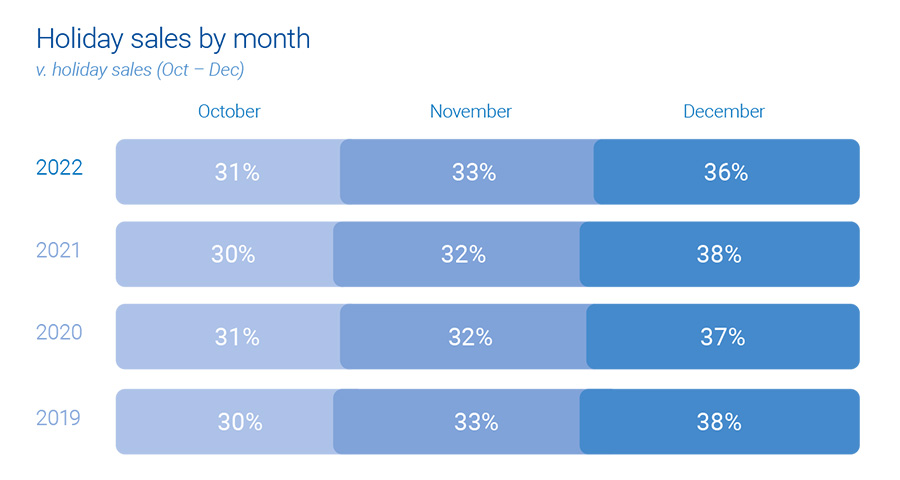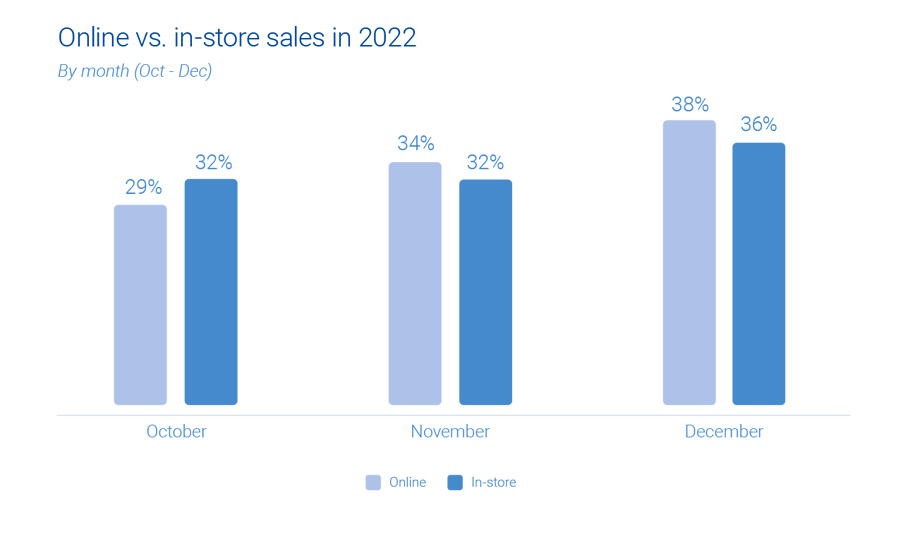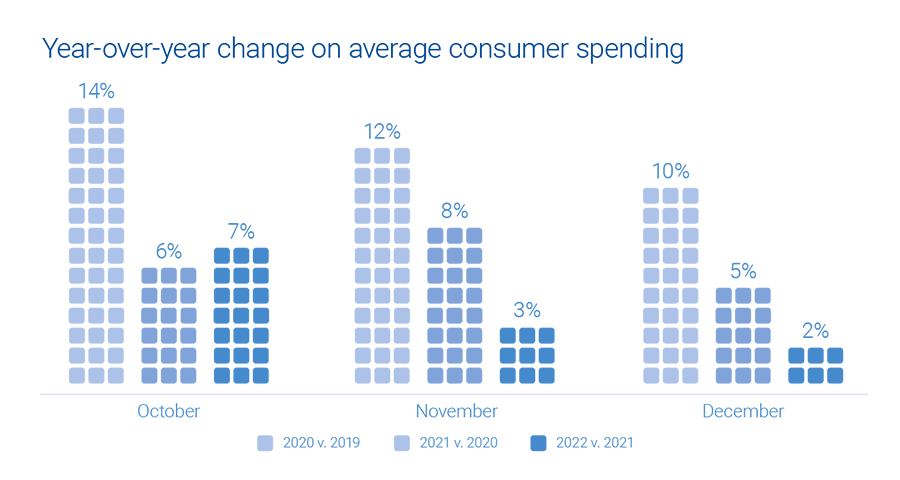
The holiday season is just around the corner, and retailers and marketers are gearing up for the busiest shopping period of the year. It’s crucial to understand how consumer behavior is evolving and what emerging trends to expect. Experian’s 2023 Holiday spending trends and insights report analyzes recent trends, consumer spending habits, and anticipates what’s to come in 2023 to help you deliver a top-notch shopping experience this holiday season.
In this blog post, we’ll cover three key insights from our report.
1. Consumers are shopping earlier
It’s no secret that December has always been the go-to month for consumers when it comes to holiday spending. However, holiday shopping now starts earlier, particularly with online sales.

This can be attributed to a surge in promotions and deals, enticing shoppers to open their wallets ahead of time, giving a significant boost to holiday sales. Notably, Cyber Week sales have proven to be an influential factor, accounting for 8% of total consumer holiday spending.
Experian tip
Reach the right shoppers with your promotions with sell-side targeting. This powerful approach gives you control over where your ads are placed while ensuring maximum visibility through direct connections with publishers. Whether on mobile, web, or CTV, this seamless ad experience will engage your audience effectively.
2. Online sales are on the rise
The popularity of online holiday sales is continuously growing, surpassing in-store shopping. There has been a consistent 1% year-over-year increase in online sales, while in-store sales have seen a 1% decrease.
“It’s easier for consumers to comparison shop for large ticket items online that they might find at a mass retailer or office supply store. Consumers prefer to have larger, bulkier items shipped directly to their home for minimal cost. By shopping online, consumers can save time since they don’t need to wait in checkout lines.”
Anna Liparoto, Sr. Account Executive, Retail & CPG

Although online sales currently make up only one-third of all holiday shopping, there is immense potential for further expansion. Mass retailers and office, electronics, and games industries particularly excel in online holiday sales. While in-store purchases remain the primary choice for holiday shoppers, consumer online and offline activities intersect before the final purchase.
Experian tip
Take advantage of the surge in online shopping by diversifying your marketing channels. An agnostic identity graph can bring together device and media data, capturing valuable user insights. By gaining a holistic view of your target audience, you’ll be able to optimize your ad spend and allocate resources effectively, ultimately boosting your return on investment.
“Omnichannel targeting during the upcoming holiday season will continue to prove to be the best way to reach scale and maximize ROI across all marketing channels.”
Joe LigÉ, Head of Enterprise Demand Partnerships
3. 2023 holiday spending will be on par with 2022
During the holiday season in 2022, consumer spending showed an anticipated increase, although the growth rate was slightly lower compared to previous years. October saw a surge in average consumer spending, indicating a swift response to early discounts and promotions offered by retailers.

As the holiday season progressed, holiday spending gradually slowed down and reached a level similar to that of the previous year. Overall, there was a modest 2% growth. Looking into the future, if economic conditions remain stable in the second half of 2023, we can expect holiday spending to align with the figures from last year.
Experian tip
To truly maximize impact, consider data enrichment. By diving deeper into your target audience’s preferences and behaviors, you can better tailor your strategies and seamlessly integrate the enriched data across various channels. This allows you to unlock the true potential of your ad inventory, creating more meaningful connections with your audience.
Download our 2024 report
Get ready for the holiday shopping season with Experian’s 2024 Holiday spending trends and insights report. Inside you’ll find:
- Analysis of past trends and what they mean for 2024
- Exclusive predictions for the upcoming holiday season
- The top audiences to activate this holiday season
To access to all of our predictions for this year’s holiday shopping season, download our 2024 Holiday spending trends and insights report today.
Latest posts

Tapad, part of Experian, integrates with MediaJel's current advertising solutions will enable U.S. brands to benefit from improved cross-device reach and targeting capabilities NEW YORK, April 14, 2020 /PRNewswire/ — Tapad, part of Experian and a global leader in digital identity resolution, has partnered with MediaJel, a leading provider of advertising and marketing solutions for regulated markets. The partnership will enhance MediaJel's current offering, enabling brands to further improve their digital marketing campaigns, and thereby, return on investment. Tapad's global, privacy-safe digital cross-device solution, The Tapad Graph, will complement MediaJel's state-of-the-art advertising solutions to identify and resolve fragmentation created by a consumer's researching and purchasing behavior across multiple digital devices. For MediaJel, this provides customers with an opportunity for incremental efficiencies across a number of use-cases, including reach extension, targeting, ad frequency capping, suppression, and attribution. Dash Rothberg, Senior Vice President of Strategic Partnerships at MediaJel commented, "With an endless list of considerations across consumer behavior, marketing fragmentation, and today's ongoing device proliferation – optimizing digital campaigns can be challenging for most brand advertisers. We partnered with Tapad after testing multiple cross-device solutions in the market but concluded that The Tapad Graph provided us with a blend of scale, quality, flexibility, and privacy-safe data to meet our customer needs." Mike Dadlani, Vice President of Agency Partnerships at Tapad added: "Our partnership with MediaJel is an exciting one. Not only will their portfolio of clients be enabled to more effectively execute and optimize cross-device campaigns, but they will also realize longer-term benefits from improved attribution and consumer insights." To learn more about Tapad and our digital identity resolution capabilities, visit our identity page. About Tapad Tapad, Inc. is a global leader in digital identity resolution. The Tapad Graph and its related solutions provide a transparent, privacy-safe approach connecting brands to consumers through their devices globally. Tapad is recognized across the industry for its product innovation, workplace culture, and talent, and has earned numerous awards including One World Identity's 2019 Top 100 Influencers in Identity Award. Headquartered in New York, Tapad also has offices in Chicago, London, Oslo, Singapore, and Tokyo. About MediaJel Founded in 2017, MediaJel acts as a full-service agency that provides advertising and marketing solutions from brand building and search optimizations to campaign execution and online-offline attribution. Built with proprietary technology, the MediaJel.io platform leverages unique actionable data for brands and agencies to effectively execute high-performance marketing campaigns. With "Data Ethics" being the core of the business, all aspects are brand safe and compliant for regulated industries. Contact us today!

The beginning of any new year brings an influx of gym goers who are committed to working on resolutions. Whether the goal is to work out or be healthier, gyms around the nation see a spike in numbers in the first few months of the new year. Experian examined foot traffic patterns for five gyms nationwide from January to June of 2019 to determine if there were significant trends. Unsurprisingly, there was a spike in visits in January, which correlates with the rise of advertising in the fitness industry during that time. We are all familiar with the ads telling us about the amazing discounts available at our nearest gyms, as well as the constant reminder that it’s a new year so it’s time to reinvent yourself – “New Year, New Me!” Even though the spike in visits in the first couple of months is exciting for businesses, research suggests that these trends won’t continue throughout the year, which means a loss of revenue over the latter half of the year. A loss of revenue is never good, so as a marketer, how can you better understand your new clients and target them when they might be inclined to throw in the towel? Taking a second look at the graph above, you see a spike in visits in late March and early April, before a big drop off in May. We were curious to see what was causing this spike, so we took a deeper dive into the data, looking at both age and gender. What we found was that from January to early March, there was a steady decline in visits, whereas in late March to early April, there was about a 7% rise in visits across the board. What was more interesting than the spike in visits, was the significant drop after the first week of April. We saw a significant 13% drop in visits on average in both males and females of all ages. On the higher end of the spectrum were both males and females between the ages of 19-34 with a 14%-15% drop in visits. While we can speculate on why there was such a drop at this time – right after spring break, etc. – gathering more data about these individuals is essential to building an effective marketing plan to combat this degradation. As a marketing professional in the fitness industry, or someone looking to target a health-conscious demographic, you need to understand your audience – both their visit patterns, as well as their likes and dislikes. Using Experian’s data, you can take a deeper dive to understand your members eating habits. For instance, you can better understand if your clients like to visit health-conscious dining establishments or do they frequent QSR locations like McDonalds. It may seem like common sense, but a successful marketing campaign is rooted in relevant messaging and relevancy is rooted in the ability to understand the target audience. While the goal is to bring new members into your gym or health club in January, the challenge is to keep those new members coming throughout the year, and that’s where there is an opportunity for marketers to better connect with these customers. If you know that people under the age of 34 are at the biggest risk of halting their visits to your fitness location in the middle of April, then you can take the next steps to better understand that demographic so you can activate an effective marketing campaign tailored to their needs before you lose their memberships. The key is to understand who these fitness resolution members are and find a way to target them before their commitment waivers. What works for one location may differ from another, so you have to include other data points in to build a more holistic view of your target audience. At the end of the day, understanding your members is key. Partnering with Experian to take a deeper dive into your members likes and dislikes, as well as their visit patterns can allow fitness locations to have the data and the tools at hand to make the right marketing decisions and deliver an effective marketing campaign, ultimately reducing the membership attrition rate.

Over the past two decades, marketers were consumed with the Millennial generation. Those individuals born between 1980 and 1995 represented a new set of consumers to the market with very different attitudes, behaviors and purchase decision styles than had previously been seen. Marketers invested significant capital to learn about Millennials and transformed their marketing strategy to better reach and attract them. Those that did this successfully were able to grow their business and extend their footprint to a new group of consumers. Now, as we enter a new decade, another generation of individuals is entering into the market and represents the future customer for marketers. Understanding who these consumers are, how to best reach them, and how they make purchase decisions will help marketers reach this new audience and grow their business more effectively. 1. Who is Generation Z? While definitions have varied from different publications, Generation Z is generally defined as consumers born between mid-1990s through early 2010s. Here, we define generations as the following: According to Kasasa, this group represents about 74 million consumers, which is similar in size to other generations.[i] Information on Generation Z is limited since many are still considered minors. However, resources such as syndicated surveys have provided some thoughts about their general attitudes that can begin to provide insight. Key Takeaway: Get to know Generation Z. They are big, they are coming, and they will likely be the future consumer you will need to attract. 2. How is Generation Z Influenced by Technology? Very much so. Generation Z individuals received their first mobile phone at age 10.3 years and spend an average of 3 hours each day on their device.[ii] They have no real understanding of what life was like before the internet. They are active users of smart phones, apps, and social media, and frequently use technology before making decisions. The internet is very important to Generation Z – they meet people, share information about themselves, get their entertainment, relax, and enjoy going online in their free time. Generation Z respondents were more likely than other generations to agree with the following statements: “I like to keep my personal Internet pages updated with information about my life.”“The internet is a good way to meet new people.”“The internet is a main source of entertainment for me.”“Going online is one of my favorite things to do with my free time.” Additionally, the mobile internet, which includes accessing social media and apps through a hand-held device, is even more meaningful to the Generation Z consumer. Generation Z respondents list the following as what the Mobile Internet means to them: “Pure entertainment”“A good escape”“Relaxes me”“Puts me in a good mood”“Keeps me up-to-date with the latest styles and trends” One result of this is how much more connected Generation Z feels with each other, and with celebrities. They actively follow and interact with their friends or celebrities through YouTube, TikTok, Twitter, Instagram, Snapchat or other social media tools. As a result, they are much more influenced by celebrities than other generations. Key Takeaway: Generation Z will be a heavy user of technology and are influence by each other and celebrities. They will expect your products to be accessible through mobile devices. 3. What media channels are best for reaching Generation Z, and what are their decision-making characteristics? To improve marketing effectiveness, marketers must know how to reach their consumers. Two significant dimensions of reach are (1) the preferred channel the consumer uses to gain awareness about a product; and (2) the decision-making style the consumer employs. Using Experian’s TrueTouchSM, marketers can learn this and develop a marketing communication strategy for improved reach. Generation Z is much more engaged through digital media. More than 3 out 4 Generation Z respondents listed the following as their preferred engagement channel: Streaming TVDigital DisplayRadio (including streaming radio)Digital VideoMobile SMS More traditional channels such as email, direct mail and traditional newspaper were ranked very low, indicating that reaching Generation Z will require marketers to move away from more traditional media channels to influence these consumers. Decision-making styles were also different for Generation Z. The most frequent Experian TrueTouch Decision-Making Styles among Generation Z respondents were: Brand loyalty was the least frequent response among Generation Z. This indicates that Generation Z may not have an automatic affinity to a brand, and that marketers may have to demonstrate its value to influence these emerging consumers. Key Takeaway: Digital media will be a key for reaching Generation Z, and marketers will have to adapt away from traditional media to influence these consumers. While recreational and “In the Moment,” Generation Z does not have loyalty to specific brands, considers what goes into products, and researches different websites and online reviews before making a purchase. In summary, Generation Z is an emerging group of consumers that will challenge marketers to think beyond traditionally successful marketing tactics. These consumers were born into a digital age, and are heavily influenced by social media, whether it’s recommendations from friends, or celebrities that endorse a certain product. This influence requires marketers to communicate more digitally, and less from traditional media like direct mail, email and newspapers. Finally, marketers will need to be aware these consumers will make purchase decisions based on research from other websites and online reviews, look for new things particularly those made with natural ingredients, and are not necessarily loyal to established brands. Knowing this will help marketers develop strategies and make the necessary investments to reach this group more effectively. [i] “Boomers, Gen X, Gen Y, and Gen Z Explained,” Kasasa, July 29, 2019. https://www.kasasa.com/articles/generations/gen-x-gen-y-gen-z [ii] Ibid